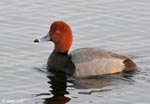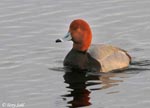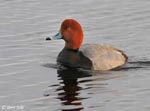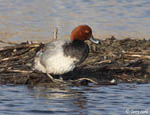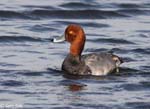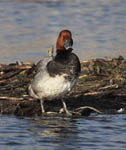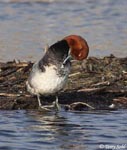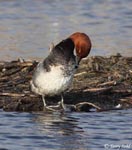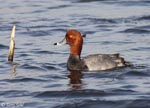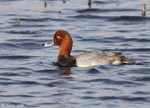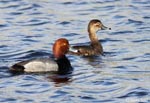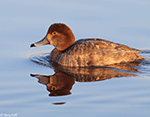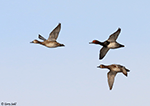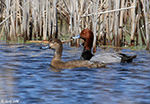| Length: 19 inches | Wingspan: 32 inches | Seasonality: Summer |
| ID Keys: Rufuous-Brown head, black breast, gray back. Compare to white back of Canvasback. | ||
 A relatively common diving duck in South Dakota, very common in both migration and
during the summer breeding season. They are one of the dabbling ducks,
primarily feeding on aquatic vegetation by dipping the front half of their body
below the surface as they forage. The
Redhead regularly lay eggs in the nests of other birds, sometimes including
non-duck species such as bitterns and herons. Some female Redheads
never raise their own young, only parasitizing other species' nests.
A relatively common diving duck in South Dakota, very common in both migration and
during the summer breeding season. They are one of the dabbling ducks,
primarily feeding on aquatic vegetation by dipping the front half of their body
below the surface as they forage. The
Redhead regularly lay eggs in the nests of other birds, sometimes including
non-duck species such as bitterns and herons. Some female Redheads
never raise their own young, only parasitizing other species' nests.
Habitat:
Redheads will utilize a variety of aquatic habitats, with nesting sites typically constructed in shallow wetlands and marshes, with thick herbaceous vegetation that provides both foraging and shelter opportunities. They will however use a very wide array of habitats, from large reservoirs, to temporary flooded ditches and fields, to small farm ponds.
Diet:
Primarily the leaves, roots, and seeds of aquatic plants. Also will occasionally feed on aquatic insects and crustaceans.
Behavior:
Forages by both diving for food and dabbling in shallow water. Gregarious, with many often nesting in close proximity, which no doubt contributes to nest parasitism with the species. Will also gather in very large flocks during migration and in winter.
Nesting:
May through July in South Dakota. The nest of a
Redhead is a shallow and sometimes relatively large bowl, constructed of
cattails and other wetland vegetation. It is typically placed in shallow
water, anchored to submerged vegetation. Sometimes they will also nest on
dry land adjacent to an aquatic habitat. The female lays between 7 and 12
eggs, and she alone incubates them. The young hatch after about 25 days, and
leave the nest shortly after, gathering their own food, but being tended to
and protected by the female.
Redheads are also a species that will parasitize nest of other Redheads or
other duck species. Female Redheads will sometimes mate, lay a number of
eggs in the nests of other birds, and then lay eggs in her own nest.
Song:
Male Redheads have a unique, haunting MEE-ough call used during courtship. Both males and females have other grunting call notes used when disturbed or in flight.
- Click here to hear the calls of a female Redhead as it's flushed and takes flight1
- Click here to hear the calls of a male Redhead2
Migration:
Summers in the northern plains, western U.S., central Canada, and locally elsewhere. Winters in the southern half of the U.S. and points south.
Interactive eBird map:
Click here to access an interactive eBird map of Redhead sightings
Similar Species:
Redhead could potentially be confused with the following species:
- Canvasback - Male Canvasbacks and male Redheads both share a rusty red head, a black breast, and a lighter colored body. However, the Canvasback male has a pure white body, while the male Redhead has a vermiculated, grayish-looking back. The head shape is substantially different if seen well, with Redheads having a rounder head, while Canvasbacks have a flatter head with a gently sloping forehead. Female Redheads could also potentially be confused with female Canvasbacks, but again, the head and bill shapes are different, and female Canvasbacks have lighter upperparts that the brownish upperparts on a female Redhead.
- Lesser Scaup - Males of the two species share the same general structure and patterns of darker and lighter feathering, but the red head clearly stands out on the male Redhead. Females are similar, but female Lesser Scaup have a white spot in front of the bill that's lacking on a female Redhead. Note Greater Scaup are very similar in appearance to Lesser Scaup, and the same ID keys thus can be used to differentiate them from Redheads.
- Ring-necked Duck - It's the female Ring-necked Duck that could potentially be confused with a female Redhead. However, female Ring-necked Ducks usually have a whitish band around the bill and a white spot between the eye and bill that are lacking on Redhead females. Female Ring-necked Ducks also tend to have more contrast between a darker back and a lighter flank and breast than on a female Redhead.
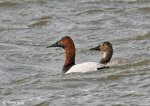 |
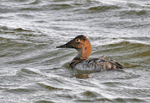 |
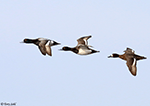 |
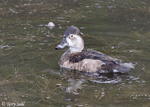 |
| Canvasback (male and female) | Canvasback (female) | Lesser Scaup (male and female) | Ring-necked Duck (female) |
Conservation Status:
Redheads have a very wide geographic range, are common in parts of that range, and systematic surveys across the past few decades show small increases in overall populations. The IUCN considers the Redhead to be a species of "Least Concern".
Further Information:
Photo Information:
April 5th, 2008 - Dewey Gevik Nature Area, Minnehaha County - Terry Sohl
Additional Photos:
Click on the image chips or text links below for additional, higher-resolution Redhead photos.
Audio File Credits:
- 1Andrew Spencer. Recorded in Burke County, North Dakota on May 10th, 2012. Original recording and information from xeno-canto.
- 2Andrew Spencer. Recorded in Burke County, North Dakota on May 10th, 2012. Original recording and information from xeno-canto.
| Click on the range map for a higher-resolution view |
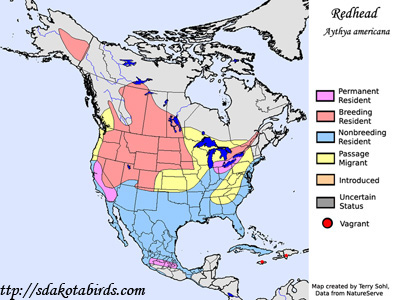 |
| South Dakota Status: Common summer resident in the eastern part of the state, less common in the west. Rare in winter. |
Additional Redhead Photos
Click for a higher-resolution version of these photos
